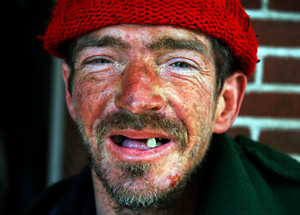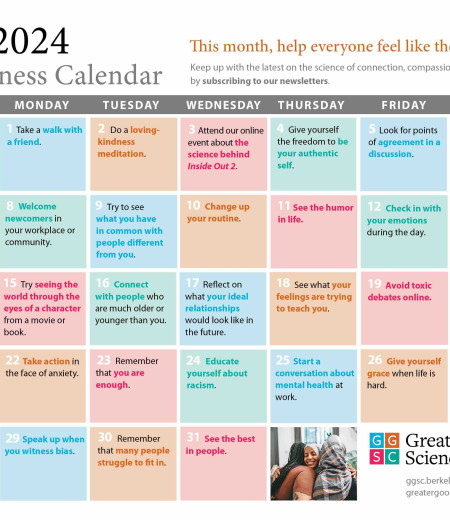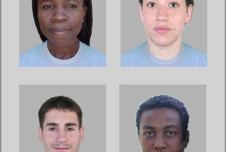How prejudiced are you?
Most people think they’re less biased than average. But just as we can’t all be better than average, we can’t all be less prejudiced than average. Although the message—and the success so far—of Barack Obama’s presidential campaign suggests an America that is moving past traditional racial divisions and prejudices, it’s probably safe to assume that all of us harbor more biases than we think.
 Within a moment of seeing a photograph of an apparently homeless man, people's brains set off a sequence of reactions characteristic of disgust and avoidance.
© Tom Stone
Within a moment of seeing a photograph of an apparently homeless man, people's brains set off a sequence of reactions characteristic of disgust and avoidance.
© Tom Stone
Science suggests that most of us don’t even know the half of it. A 20-year eruption of research from the field of “social neuroscience” reveals exactly how automatically and unconsciously prejudice operates. As members of a society with egalitarian ideals, most Americans have good intentions. But new research suggests our brains and our impulses all too often betray us. That’s the bad news.
But here’s the good news: More recent research shows that our prejudices are not inevitable; they are actually quite malleable, shaped by an ever-changing mix of cultural beliefs and social circumstances. While we may be hardwired to harbor prejudices against those who seem different or unfamiliar to us, it’s possible to override our worst impulses and reduce these prejudices. Doing so requires more than just good intentions; it requires broad social efforts to challenge stereotypes and get people to work together across group lines. But a vital first step is learning about the biological and psychological roots of prejudice.
Modern prejudice
Here’s the first thing to understand: Modern prejudice is not your grandparents’ prejudice.
Old-fashioned racism and sexism were known quantities because people would mostly say what they thought. Blacks were lazy; Jews were sly; women were either dumb or bitchy. Modern equivalents continue, of course—look at current portrayals of Mexican immigrants as criminals (when, in fact, crime rates in Latino neighborhoods are lower than those of other ethnic groups at comparable socioeconomic levels). Most estimates suggest such blatant and wrongheaded bigotry persists among only 10 percent of citizens in modern democracies. Blatant bias does spawn hate crimes, but these are fortunately rare (though not rare enough). At the very least, we can identify the barefaced bigots.
Our own prejudice—and our children’s and grandchildren’s prejudice, if we don’t address it—takes a more subtle, unexamined form. Neuroscience has shown that people can identify another person’s apparent race, gender, and age in a matter of milliseconds. In this blink of an eye, a complex network of stereotypes, emotional prejudices, and behavioral impulses activates. These knee-jerk reactions do not require conscious bigotry, though they are worsened by it.
In my own lab, for example, we dug up dozens of images of societal groups that were identifiable in an instant: people with disabilities, older people, homeless people, drug addicts, rich businessmen, and American Olympic athletes. We asked research participants to tell us what emotions these images evoked in them; as we predicted, they reported feeling pity (toward the disabled and elderly), disgust (the homeless and drug addicts), envy (businessmen), and pride (athletes).
We then slid other participants into a functional MRI scanner to observe their brain activity as they looked at these evocative photos. Within a moment of seeing the photograph of an apparently homeless man, for instance, people’s brains set off a sequence of reactions characteristic of disgust and avoidance. The activated areas included the insula, which is reliably associated with feelings of disgust toward objects such as garbage and human waste. Notably, the homeless people’s photographs failed to stimulate areas of the brain that usually activate whenever people think about other people, or themselves. Toward the homeless (and drug addicts), these areas simply failed to light up, as if people had stumbled on a pile of trash.
We were surprised—not by the clear sign of disgust, but by how easy it was to achieve. These were photographs, after all, not smelly, noisy, intrusive people. Yet we saw how readily physical characteristics could evoke strong, immediate, and deep-seated emotional reactions. Results like these have obvious implications for racial prejudice, which is often elicited by similarly superficial characteristics. Indeed, a great deal of recent research has shown how our knee-jerk biases are directed toward members of other races.
Research by NYU psychologist Elizabeth Phelps and her colleagues has found that even dull yearbook photographs can trigger a strong neural response. When white men in their study briefly saw pictures of unfamiliar black male faces, their brain activity spiked in a region known as the amygdala, which is involved in feelings of vigilance generally, and in the fear response specifically; the amygdala lights up when we encounter people or events we judge threatening. Several other labs, including my own, have uncovered a similar link between amygdala activity and white people’s perceptions of black faces.
Other research has uncovered more subtle forms of racial bias. In one study, neurosurgeon Alexandra Golby and her colleagues showed participants images of white and black faces. When white participants saw white faces, their brains showed more activity in a region that specializes in facial recognition than when they saw black faces; the same went for black participants when they saw black faces. For some reason, those other-race faces didn’t register as human faces in the same way that same-race faces did. Later, all participants saw a series of white and black faces, some of which were new faces and some of which were faces they’d already seen during the brain scans. Sure enough, both white and black participants proved better able to remember people of their own race.
Work by Stanford psychologist Jennifer Eberhardt and her colleagues suggests that these rapid, unconscious facial perceptions can have deadly consequences. The researchers had participants analyze photos of African-American men convicted of murder, rating how “stereotypically Black” the men’s facial features appeared. Some of the men had been sentenced to the death penalty; some had been given less severe sentences, though the participants didn’t know which men were which. Even after controlling for relevant variables such as the severity of the murder and the defendant’s facial attractiveness, socioeconomic status, and prior convictions, it turned out that black men were more than twice as likely to be sentenced to death if they had more “stereotypically Black” facial features. (However, this discrepancy only existed if the murder victim was white. The defendants were no more likely to get the death penalty if their victim was also black.)
Meanwhile, in studies mimicking how the police deal with criminal suspects, University of Chicago psychologist Joshua Correll and colleagues have shown that police officers, community members, and students playing a video game are faster to “shoot” an armed black man than an armed white man, but they’re faster to avoid shooting an unarmed white man than an unarmed black man. Cultural stereotypes and emotional prejudices register on the brain as quickly as a fifth of a second—enough time to determine whether a suspect lives or dies.
Us vs. not-us
Years before these neuroscience findings, social psychologists had documented the instant (and unfortunate) associations people make toward “out-groups”—those groups they don’t consider to be their own. Whether they differ by age, ethnicity, religion, or political party, people favor their own groups over others, and they do so automatically. We have always had codes: PLU (people like us), NOKD (not our kind, dear), the ’hood, the Man. Every culture names the “us” and the “not-us.” It appears to be human nature, and many studies have shown how easy it is to provoke this kind of psychological distinction between our “in-groups” and “out-groups.”
In one of the most famous of these studies, pioneering social psychologist Henri Tajfel showed teenage boys paintings by Klee and Kandinsky and asked them which artist they preferred. Tajfel then gave the boys the chance to distribute money to others who preferred the same artist, or to those who liked the other artist. The Klee boys were significantly more likely to give money to other Klee fans; Kandinsky boys were significantly more likely to share with other Kandinsky-ites. They proved decidedly loyal to their groups, even though they’d become affiliated with this group just minutes earlier, knew nothing else about their fellow group members, and ostensibly had nothing to gain from their group membership.
Similar studies have shown that people demonstrate strong preferences toward those wearing the soccer jersey of a team they like, people who share their birthday, and people who subtly resemble themselves, not to mention those of their own race or ethnicity.
Conditioned by millennia of tribal warfare and fierce competition for limited resources, we are always looking for cues to help us make snap judgments about others. Unfortunately, as we gravitate toward the familiar and the similar, all too often we rely on physical characteristics to determine whether someone is in our in-group or out-group. In that light, it’s not hard to understand why so much prejudice is directed at people based on their race.
What’s more, we all have to contend with our culture’s influential role in shaping prejudice. Years, even generations, of explicit and implicit cultural messages—gleaned from parents, the media, first-hand experiences, and countless other sources—link particular physical appearances with a host of traits, positive or negative. The roots of these messages can stretch back centuries, as is the case with racism toward African Americans in the United States and its origins in the age of slavery. Such messages are absorbed, accepted, and perpetuated, often unconsciously, by our culture’s members and institutions. That’s how prejudices become so widespread and automatic.
A fight we can win
People have a tendency to think that biology is destiny. But just because we can correlate impulses in the brain with certain prejudices does not mean we are hardwired to hate drug addicts and homeless people, or that members of different races are destined to fear and mistrust one another.
In the neuroscience studies looking at race, for instance, amygdala (vigilance-related) reactions vary by individual, corresponding to other signs of prejudice. People who exhibit more prejudiced attitudes or behaviors, for example, show more amygdala response. And the alarms in Whites’ amygdalas do not go off to famous black faces. Likewise, their brains grow accustomed to new black faces after repeated exposure.
Ohio State researcher William Cunningham has even found that, among Whites, black faces trigger more amygdala activity only when these faces were seen for a length of time (30 milliseconds) so short that it amounts to subconscious exposure. When Whites had the chance to see black faces for a bit longer (525 milliseconds) and process them consciously, their amygdala activity wasn’t unusually high; instead, they showed increased activity in brain areas associated with inhibition and self-control. It was as if, in less than a second, their brains were reining in unwanted prejudices.
The most important lessons of this whole wave of research point to the complexity of the interactions between biology and environment.
Take the amygdala race results. When researchers just slightly change the social context in which people view photos of other races, we’ve seen changes in the ways their brains react to these faces.
In my own lab, for instance, we showed white study participants a series of photos, some of white faces and some of black ones. We gave them two seconds to answer one of three questions about the people in these photos: whether they were over 21, whether they had a gray dot on their face, or whether they liked a certain vegetable. When participants had to decide if the people in the photos were over 21, we saw a spike in their amygdala activity, similar to what had been found in the studies I mentioned earlier. But when they looked at these faces to judge what kind of vegetable the person would like, or when they were looking for a gray dot, their amygdala activity was the same as when they saw white faces.
In other words, when our study participants had to place others into a social category—even if it was by age, not race—they saw black faces differently than white faces. But the gray dot exercise showed it was possible for Whites to look at black faces without getting this effect. More important for everyday interactions, when participants were prompted to judge these people as individuals—individuals with their own unique tastes and preferences—they reacted no differently to black faces than they did to white ones. Similarly, my lab’s latest brain scans indicate that people stop dehumanizing homeless people and drug addicts when they’re made to guess what these people would like to eat, as if the study participants were running a soup kitchen.
What this research suggests is that the environment can interact with human nature for good or ill; social conditions can reduce prejudice, just as they can foster or exacerbate it.
Both science and history suggest that people will nurture and act on their prejudices in the worst ways when these people are put under stress, pressured by peers, or receive approval from authority figures to do so. We see this in hate crimes directed at homeless people, gays and lesbians, and all ethnicities; my former students Lasana Harris, Amy Cuddy, and I have argued that these processes lie at the root of prisoner abuse in settings such as Abu Ghraib.
Fortunately, research has also indicated which kinds of social conditions can reduce prejudice. For instance, a long line of my previous research indicates that putting people on the same team helps to overcome prejudices over time. In one study, my former student Steve Neuberg and I found that study participants had negative feelings toward a schizophrenic patient recently discharged from a mental institution—unless they were told they’d have to work with him for a chance to win a significant monetary prize. Then they noticed and judged him more by his own unique, individual traits, not by the traits associated with his stigmatized group.
Our results echo the famous “Robbers Cave” experiment led by Muzafer Sherif, a founder of social psychology. Sherif brought two groups of boys to separate parts of a campground and encouraged each group to bond as a team, not telling them about the other group at first. But as both groups became aware of the other one, a fierce rivalry developed between them. Yet Sherif and his colleagues soon posed a series of challenges to the groups that neither could solve without the help of the other. As they started to work together, their old tensions dissipated and they bonded across group lines.
These findings are part of a long line of research supporting what’s known as the Contact Hypothesis, which states that under the right conditions, contact between members of different groups can reduce conflicts and prejudices. Decades of school desegregation research support this idea, as documented by University of California, Santa Cruz, professor emeritus Thomas Pettigrew and University of Massachusetts, Amherst, psychologist Linda Tropp.
Pettigrew and Tropp have found that school integration can in fact reduce prejudice among students from different groups, but simply placing these students together isn’t enough to get them to see each other as individuals and shed their prejudices. We must also try to help them share common goals, on which they must cooperate to succeed; ensure that they’re treated as equals and have positive, noncompetitive interactions with one another; and feel like their cross-group relationship has the support of authority figures. The more of these factors in place, the more likely people are to overcome their biases. This has proven to be true not only in schools but in a variety of other social institutions, from the military to public housing projects. Our biases are not so hardwired after all, given the right social engineering.
As a society, we engage in social engineering all the time, mostly by accident and without intending or even anticipating all the consequences. For example, we admit athletes and the children of alumni to colleges under unexamined kinds of affirmative action that dwarf racial affirmative action. Colleges even practice affirmative action for high school boys, whose grades and test scores on average are lower than girls’. Affirmative action by race is a more-examined form of social engineering, but it is only one among many.
Because of other forms of social engineering—the kind perpetrated by biased real estate agents and job interviewers—today we remain racially segregated in our neighborhoods and workplaces. This holds true even after accounting for social class. As a result, people are deprived of daily interactions with others who might seem superficially different from themselves, but who in fact share the same values, hopes, and fears.
When we allow our society to remain so segregated, as documented by my husband, sociologist Doug Massey, then all else follows: The less fortunate are exposed to violence and disorder, receive an inferior education, have fewer local job opportunities, and lack constructive role models. Once we understand how automatically people fear difference, dehumanize the less fortunate, and demonize the Other, we can better appreciate how these forms of segregation can perpetuate themselves, and why we must fight against them. The science of human prejudice suggests that, if we’re informed and persistent, this is a fight we can win.




Comments